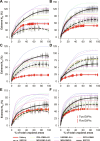Mitigating nitrogen losses with almost no crop yield penalty during extremely wet years
- PMID: 38416832
- PMCID: PMC10901370
- DOI: 10.1126/sciadv.adi9325
Mitigating nitrogen losses with almost no crop yield penalty during extremely wet years
Abstract
Climate change-induced precipitation anomalies during extremely wet years (EWYs) result in substantial nitrogen losses to aquatic ecosystems (Nw). Still, the extent and drivers of these losses, and effective mitigation strategies have remained unclear. By integrating global datasets with well-established crop modeling and machine learning techniques, we reveal notable increases in Nw, ranging from 22 to 56%, during historical EWYs. These pulses are projected to amplify under the SSP126 (SSP370) scenario to 29 to 80% (61 to 120%) due to the projected increases in EWYs and higher nitrogen input. We identify the relative precipitation difference between two consecutive years (diffPr) as the primary driver of extreme Nw. This finding forms the basis of the CLimate Extreme Adaptive Nitrogen Strategy (CLEANS), which scales down nitrogen input adaptively to diffPr, leading to a substantial reduction in extreme Nw with nearly zero yield penalty. Our results have important implications for global environmental sustainability and while safeguarding food security.
Figures






Similar articles
-
Extreme weather-year sequences have nonadditive effects on environmental nitrogen losses.Glob Chang Biol. 2018 Jan;24(1):e303-e317. doi: 10.1111/gcb.13866. Epub 2017 Sep 21. Glob Chang Biol. 2018. PMID: 28805279
-
Extreme precipitation indices over India using CMIP6: a special emphasis on the SSP585 scenario.Environ Sci Pollut Res Int. 2023 Apr;30(16):47119-47143. doi: 10.1007/s11356-023-25649-7. Epub 2023 Feb 3. Environ Sci Pollut Res Int. 2023. PMID: 36732454
-
Impacts of climate variability and adaptation strategies on crop yields and soil organic carbon in the US Midwest.PLoS One. 2020 Jan 28;15(1):e0225433. doi: 10.1371/journal.pone.0225433. eCollection 2020. PLoS One. 2020. PMID: 31990907 Free PMC article.
-
Pulse-based cropping systems for soil health restoration, resources conservation, and nutritional and environmental security in rainfed agroecosystems.Front Microbiol. 2023 Feb 3;13:1041124. doi: 10.3389/fmicb.2022.1041124. eCollection 2022. Front Microbiol. 2023. PMID: 36817102 Free PMC article. Review.
-
Amelioration of plant responses to drought under elevated CO2 by rejuvenating photosynthesis and nitrogen use efficiency: implications for future climate-resilient crops.Photosynth Res. 2021 Dec;150(1-3):21-40. doi: 10.1007/s11120-020-00772-5. Epub 2020 Jul 6. Photosynth Res. 2021. PMID: 32632534 Review.
Cited by
-
Global overlooked multidimensional water scarcity.Proc Natl Acad Sci U S A. 2025 Jul;122(26):e2413541122. doi: 10.1073/pnas.2413541122. Epub 2025 Jun 23. Proc Natl Acad Sci U S A. 2025. PMID: 40549919
References
-
- Hasegawa T., Sakurai G., Fujimori S., Takahashi K., Hijioka Y., Masui T., Extreme climate events increase risk of global food insecurity and adaptation needs. Nat. Food 2, 587–595 (2021). - PubMed
-
- Stott P., How climate change affects extreme weather events. Science 352, 1517–1518 (2016). - PubMed
-
- Ogega O. M., Koske J., Kung’u J. B., Scoccimarro E., Endris H. S., Mistry M. N., Heavy precipitation events over East Africa in a changing climate: Results from CORDEX RCMs. Climate Dynam. 55, 993–1009 (2020).
-
- Harp R. D., Horton D. E., Observed changes in daily precipitation intensity in the United States. Geophys. Res. Lett. 49, e2022GL099955 (2022).
LinkOut - more resources
Full Text Sources

